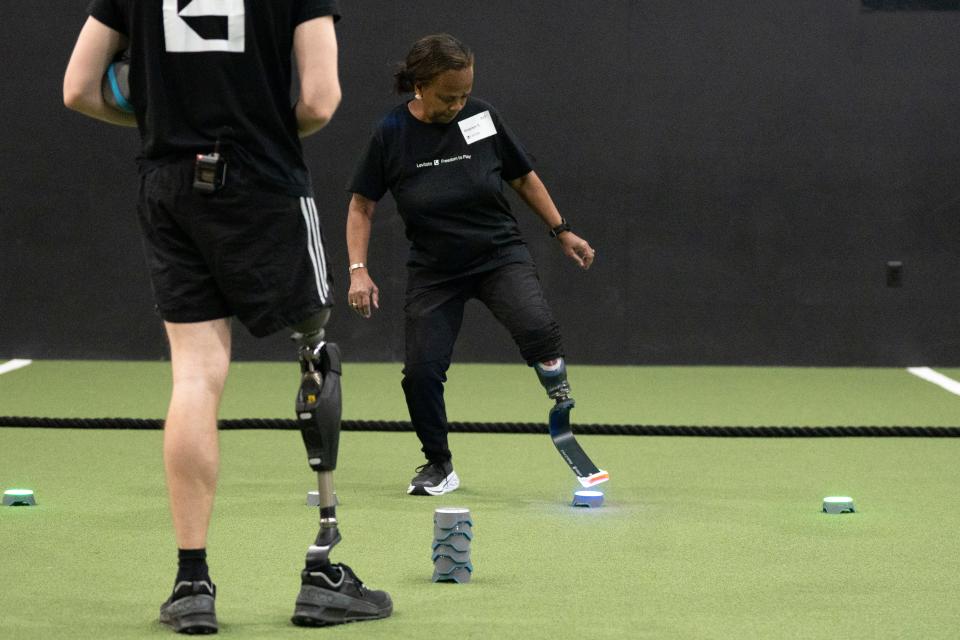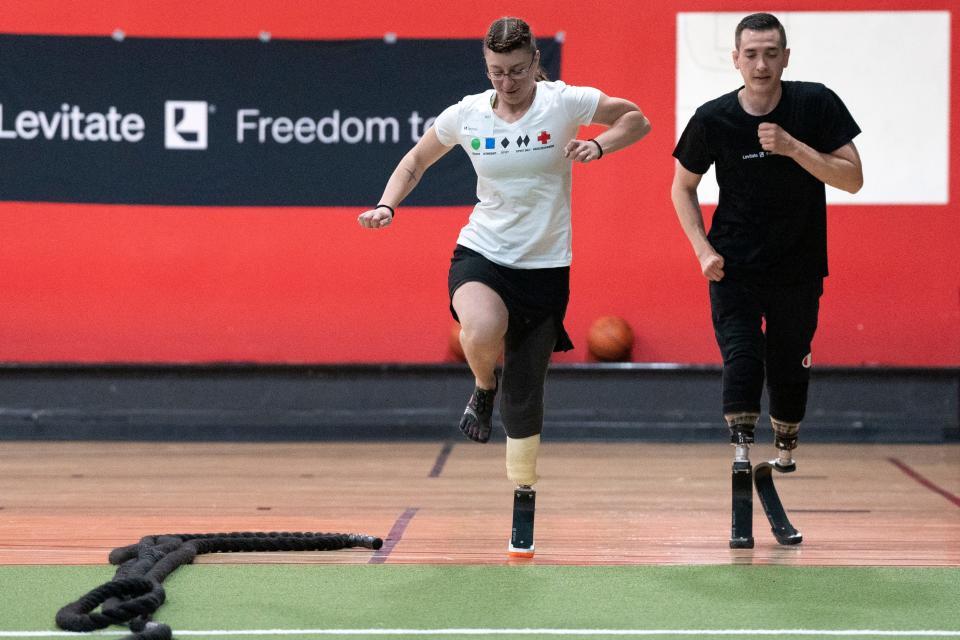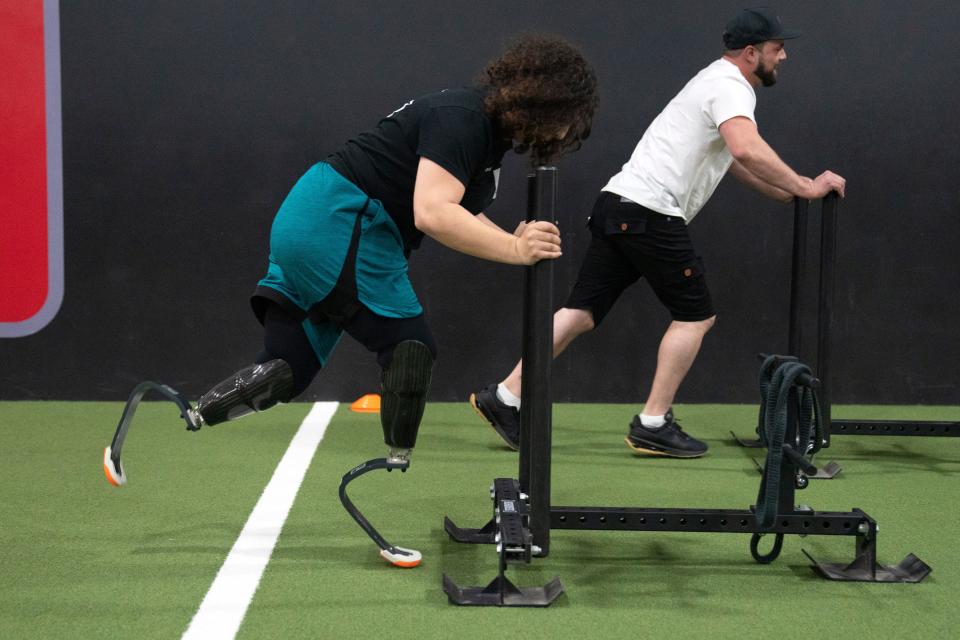Amputees test out new running blades at Upper Saddle River event, seeking active lifestyles
UPPER SADDLE RIVER — After Sharon Clarke had her foot amputated, it took her years to get back on the starting line — even though she works for Achilles International, a nonprofit that empowers people with disabilities through physical activity.
Running even a few blocks can be difficult on a traditional prosthesis, let alone a 5K.
Clarke and about 20 other amputees from at least five states tested new fiberglass running blades from Levitate on Saturday, as part of the Danish company’s Freedom Tour Test Run. Unlike a traditional prosthetic limb, which ends in a foot that fits into a sneaker, the blade is curved and enables the wearer to propel themselves forward more efficiently.

Even before Levitate made it to D1 Training in Bergen County, Clarke — whose foot was amputated due to peripheral vascular disease — had made up her mind to buy a running blade and establish new personal records. Saturday's Freedom Tour stop gave her a chance to try it out in a community of other amputee athletes — most of whom knew one another via social media but had not met in person before.
"I was afraid to show my disability. That's the bottom line," said Clarke, a Fort Lee resident. "If I show the blade, everyone's going to know I'm an amputee. I'm five years out (from amputation) now. Definitely at the beginning I was not ready to do that, but I think at this point I've evolved. I'm ready."
Building an active amputee community
The newcomers were tentative at first, awkwardly feeling the difference from their own prosthetic legs. Some tumbled, laughing as they popped off the green floor and black padded wall.
Almost everyone advanced to traditional fitness drills, like box jumps and vertical leaps, ladder agility, and balance trainers. They ran on treadmills, beat a group of non-amputees in a tug-of-war, and wrapped up the clinic with a mixed volleyball game.
"If you wear a regular walking foot (prosthesis), you can max that thing out just walking," said Douglas Carmen of Belvidere, an above-knee amputee.
"You need that springiness to launch you into a regular cadence for running," he said. "I think I could catch a 3-year-old if I need to, and I've been blown away by a 3-year-old."
More: Limb loss can make being active in New Jersey expensive. These resources can help
According to the Centers for Disease Control and Prevention, nearly one in four Americans has a disability, and about 14% of them affect mobility. But nearly half of adults with disabilities get no aerobic physical activity, the CDC website says.
Matthew Bender, a police officer in Clarkstown, New York, defies the statistics by competing in Tough Mudder races; playing lacrosse with his son; and trying to keep up with his 16-year-old distance-running daughter, who he said is "a little faster than me." After Levitate's Saturday clinic, he had a gig in Clifton playing bagpipes with a rock band.
Bender's left leg was amputated below the knee after an October 2021 motorcycle accident. He was back onstage three weeks after getting his prothesis in January 2022, and returned to full duty "with no restrictions" the next month.
"My job wanted to retire me. Don't tell a Marine we can't do something," Bender said.
Problems paying for prostheses

For the nearly 2 million Americans who have lost a limb, the message that you can't do something often comes from an insurance company.
Though most employer-sponsored and Affordable Care Act plans include “medically necessary” prosthetic devices in the list of essential health benefits that they provide, coverage is not universally available.
Medicaid programs don't offer those benefits in states including Oklahoma, Texas and Mississippi. Medicare Part B covers durable medical equipment, a category that includes canes and walkers as well as prostheses, but it requires patients to pay 20% of the cost. For a basic lower leg prosthesis, that comes to about $5,000.
“If the device(s) are determined to be medically necessary based on a diagnosis by a doctor or other licensed practitioner, they can be covered. It’s case-by-case depending on the situation,” New Jersey Department of Human Services spokesman Tom Hester said via email.
“Medicaid and Medicare cover specialty equipment to support activities of daily living," Hester said. "Medical equipment required exclusively for sports would not be covered by either program.”
‘I can do more’: NJ kids with physical disabilities struggle to play, compete
Specialized exercise-specific equipment to run, lift weights and do other physical activities costs tens of thousands of dollars, none of which is covered by insurance.
Levitate sells fiberglass running blades for about $2,000.
"Our health care system does not try to help people. It's all about the money," said Tony Cappelletti of Poughkeepsie, New York, whose left leg was amputated below the knee after a motorcycle accident two years ago. Cappelletti raises funds for Less Leg More Heart, a nonprofit that supports amputees' transitions into their new lives.

The nonprofit has gifted Levitate blades to Freedom Tour participants in Denver, Dallas and Boston. Ammarae Eusepi, 23, was Saturday's grantee, and was fitted before she and her mother made the four-hour drive back home to the Syracuse suburbs.
None of Levitate's products are custom made. They're all off the shelf, designed to be screwed into an amputee's existing socket — the portion of a prosthesis that slides over the user's remaining limb. That makes the blades easier to fit, allowing users to switch smoothly from one artificial limb to another for different purposes.
The Freedom Tour Test Run moves on to Houston on June 3, and there will be four California stops in June and July.
"Levitate is trying to change the relationship between amputees and their prosthetic legs. That's a passion project I would love to get behind," Cappelletti said, noting that April is Limb Loss and Limb Difference Awareness Month.
"When it comes to people trying to exercise, there's a line, and I like to push that line farther toward amputees and not big companies. Your mission should be to make blades for people to run again."
Jane Havsy is a storyteller for the Daily Record and DailyRecord.com, part of the USA TODAY Network. For full access to live scores, breaking news and analysis, subscribe today.
Want to share your story with me?
Email: JHavsy@gannett.com
Twitter: @dailyrecordspts
This article originally appeared on Morristown Daily Record: Levitate Freedom Tour showcases running blades in Upper Saddle River

